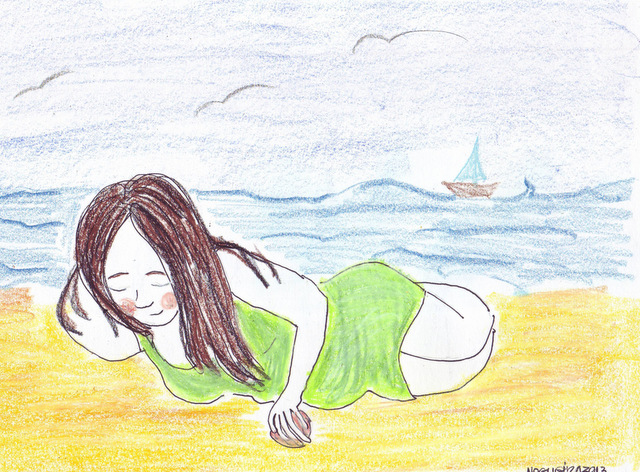Not Waving, but Drowning: Surviving Moods and Depression

One moment you are swimming. Life is pleasant and the water is warm. The sun shines down, warming your face and glinting off the water. The next moment, life seems to change. The sea forms waves, and it feels as if you have forgotten how to swim. You feel so tired and overwhelmed.
These are the waves of life. Sometimes we bob around, laugh and wonder at the world; other times we are caught in eddies, storms and giant waves. How did we get here? How does the sea look like glass one day and the next day like a scene from a Hollywood disaster film?
Have you noticed your internal weather systems? Have you noticed how sometimes you simply wake up on the wrong side of the bed and everyone around you looks like an annoying idiot? It can feel like a being on a choppy sea, or as if a huge fog has settled on and around you.
What do most of us do in this situation? Usually we start to experience internal stories about how bad our life is, how rude/daft people are around us, or how we really shouldn’t feel this way. All these stories do an excellent job of increasing the velocity, intensity and length of the storm. My particular favourite is, “How can I be down again? What happened? What can I read or watch to improve this?” I have a great ability to create a whirlpool by trying to think my way out of it. What’s your favourite (I say this with tongue firmly in cheek) story that you tell yourself when you are in a slump? How do you weave the threads of your life to create the “reason” you feel so bad? Does it help or make you sink faster?
Have you ever known a storm to stay? Even the most frightening of hurricanes swirls through and blows itself out. So it is true with our moods and emotions. When we are in the middle of a mood storm, it feels like it will stay forever. It becomes who we believe ourselves to be: “I am tired”; “I am low”; “I am depressed.” We start to identify with the mood, with the emotions that we create with our thinking about the mood. The mood is not who we are; but if we cling to it, get involved in it, try to analyze our way out of it, the storm will surely stay around a lot longer.
The storm will pass; we just have to wait it out from a safe place. What does this mean in our day-to-day lives? Put off BIG, life-changing decisions (consider yourself a little drunk, which is not a great time to get that tattoo!), and be aware that some of the things you say to others may not be the most helpful or even nice. It is an absolutely bad idea to sit down and have it out with a friend, partner or children. Your thinking is of low quality – everything looks kinda freaky, so, trust me, the conversation will not go well. It is the equivalent of drunk-dialling your ex…not the best plan.
Garret Kramer has a wonderful metaphor (which to your relief involves no ocean-related metaphors) for how we feel when we are “in a mood.” Kramer uses the example of an elevator. When the elevator is in the basement, everything looks dark, crummy, mean, insecure, judgmental and anxious. As our mood rises, just as an elevator rises, we feel lighter. By the time the elevator reaches the Penthouse Suite we feel amazing, compassionate, loving, happy and inspired. This elevator rises and falls of its own accord. The only thing we know for sure is that it will move, and that change is the nature of life.
Do you notice what is in your head when you are in a low mood? My goodness, that voice can be crazy nasty! I was there for at least a year, lost in a storm of sorrow, anxiety, fear and depression. Everything seemed to be so much hard work, on the verge of going catastrophically wrong, and I concluded that I was a dumb, depressed idiot with no future. Finally I was thrown a lifesaver ring, just as I felt I was drowning, by a friend who asked me just one question: “What are you thinking just before your energy drops?”
In my low state, I was buying into every thought that flew into my head. “Yes! I am a stupid mother!” “No! I couldn’t possibly look after this baby successfully!” “Yes! I am a failure!” I believed each and every one of those thoughts, and I continued to chew them over in my mind. My thoughts created a whirlwind of emotions, and I stayed trapped.
“All feelings derive and become alive, whether negative or positive, from the power of thought.” – Sydney Banks
It was only when I started to see the thoughts as something separate from me – a voice that sounded like me but really wasn’t – that I learnt not to believe every.single.thing that I heard in my head. Many of my thoughts, after a year of being stuck down so low, were on weird tape loops: see a situation and a negative tape plays, creating negative emotions. I was becoming a mother on automatic.
Only when I stopped engaging in my negative thinking did I give the storm permission to move on. I still had the low thoughts (still do sometimes), but I don’t dwell on a given thought anymore; I let it go. It is never the first thought that causes the painful emotions: it is the second, third, fourth…twentieth.
“You cannot prevent the birds of sorrow from flying over your head, but you can prevent them from building nests in your hair”. Chinese Proverb
No matter what the state of the sea, no matter how big the waves, that situation will pass. We are not, nor have we ever been, broken pieces of flotsam and jetsam being tossed around by our moods and the world. We are always whole, delightful and untainted.
Our thinking may weave stories about how our childhood did this and that to us, how our partners behaved badly, how life beat us to a pulp. This thinking creates layers and layers around us that are so heavy that we feel we will be pulled under the water. Some of us spin a reality in which we identify so strongly with these layers that we see them as who we are, standing strong, the survivor. Bryon Katie famously asks, “Who would you be without your story”? Consider that the layers of thought are blinding you from the diamond that you truly are. You are hidden from yourself, and you are more beautiful than anything your thinking could come up with. Then you can truly surf the waves of emotion with grace.
By Tammy Furey
Tammy is a coach, writer and blogger who lives in St. Gallen with her husband and daughter whilst attempting (badly) to speak German and fold her paper recycling in the correct manner. Visit her at www.fureycoaching.com. She also runs a free expat Facebook support group for mums: www.facebook.com/groups/whiteknuckleparenting/ (if link doesn’t work, type the address into your browser).
Illustration by Albina Nogueira
Albina Nogueira has been a primary school teacher since 1992, and a writer and illustrator since 2006. She currently lives in Switzerland, but her homeland is Portugal. She is also the author of Letters to Grandparents and Hairdresser. To find out more, like her on Facebook or see her books in Amazon.




I will save this piece for those times when my elevator is in the basement. Good read and so true!
Thank you Rita!